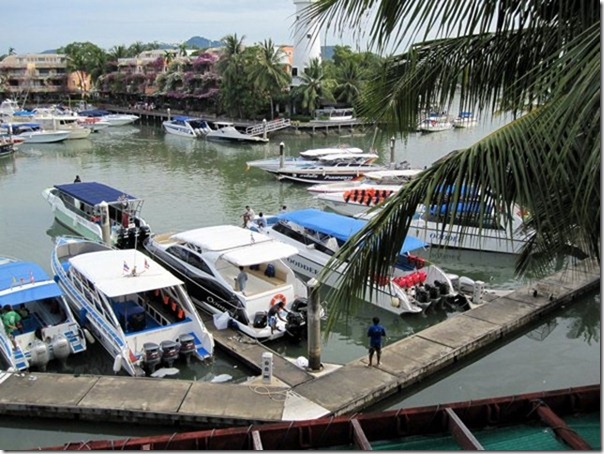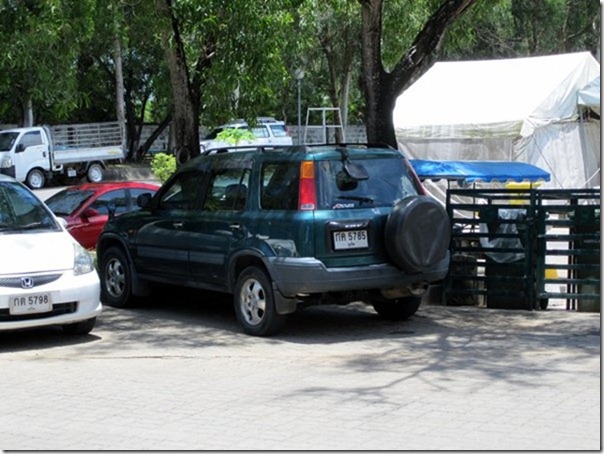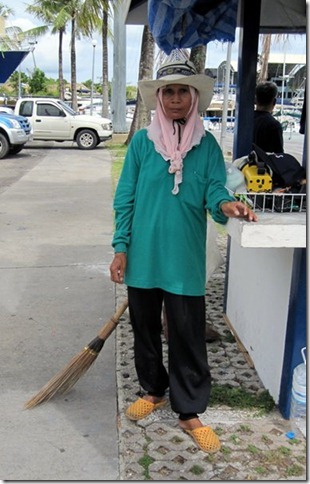Another trip to Thailand

JJMoon Diary
Barry and Margaret Wilmshurst
Mon 16 Apr 2012 04:18
|
We have been up here in the Boat Lagoon marina for
three weeks now; another week to go. And another blog about bits and
pieces on the boat. We have had:
All in all it has gone well, including the
lifting and splashing, which always raises the blood pressure a little, but
without real cause.
The little repair to the rudder skeg (the substantial
support to the leading edge) tempts me to bang on about one of the bees in my
bonnet. Of course, as we get older these buzz with increasing velocity and
volume and the temptation becomes greater. Currently there is more talk in
the yachting press of keels falling off racing boats.
Appalling. But I cannot understand how people can set off long-distance
cruising with lightly built, totally unsupported spade rudders. We are all
practically bound to hit the bottom at some time or other or to be slammed down
on our beam ends by a big sea and it is truly alarming to see so many bent and
damaged rudders.
A minor triumph was the overhaul of the ship’s bike.
One new tyre, two brake cables and a gear cable renewed. Beautifully
smooth and responsive. We hadn’t realised how cranky it had become.
We have been staying in a comfortable room, two
floors up, with a very good view of the day to day business of the marina.
This consists mainly of the transportation of hundreds of holidaymakers to and
from the local, and not so local, beauty spots. They have to get across to
Phi Phi Don in an hour or so and the bigger speedboats have three 225 hp Suzukis
across the back. There is tremendous hustle and bustle below our balcony
every morning with purposeful shepherding of very mixed bunches of lightly clad
tourists determined to have a good time. Smoky exhausts and revving
engines. Five minutes after lift-off the boats emerge from the narrow channel
through the mangroves (maximum permitted speed 5 knots) like a swarm of bats out
of Hell and roar away towards the beauty spots. Well, they are beautiful
spots between four o’clock in the afternoon and ten the next morning. They
gave us quite a scare as we made our way in three weeks ago, even though we had
a pilot on board. Two boats together round a blind corner at 25
knots. Probably they had seen our mast but one cannot help forecasting a
terrible accident some time. Once they get into the wide open spaces they
lift their noses and start to really motor. Between four and five each
afternoon they all swarm back. Some holidaymakers clap as the captain
nudges stern first into his berth, others look a bit frazzled - windswept and
sunburned. Fleets of mini-buses return them to their hotels. Despite
the apparent naffness of the operation it is really rather impressive.
There are four young men on each of the larger boats, two or three on the
smaller. Under way there is always one man stationed right aft, usually
standing on the rear platform holding a vertical support like an old-fashioned
bus conductor, presumably to catch small tourists as they fly off the
back. Most of the boats seem to be in use every day and on return they
have to be cleaned, washed down and re-fuelled. Snorkelling gear and life
jackets must be checked and washed and in the morning the boats have to be
restocked with water and soft drinks. Engines need routine servicing and
repair. It seems the lads work pretty hard and someone has got some good
business going.
1. Power boats awaiting the day’s tourist group 2. Our hire car – a real luxury! Each time we return we get a bit more out of the
experience. The local tradesmen see us coming and smile (humph!), our
yachtie friends welcome us back and we manage to widen our metaphorical
horizons. This time we have been introduced to new friends who recently
carried out a major refit over a period of 13 months. They rented a house
on a nearby estate and are a mine of information about local restaurants and
shops previously unknown to us. We have been invited to join a three-crew
syndicate to share a car. £80 a
month for transport more or less whenever we want it – particularly valuable for
a hour or two in the evening. Then there are the ready smiles from the
girls in the office and other employees. In particular perhaps, the
sweeping lady. Labour is very cheap in Thailand and there are numerous
cleaners, gardeners and sweepers. This lady rules the roost over the
area of hard standing and is always on duty, always sweeping, with a constant
smile, looking for opportunities to be helpful. When an owner emerges or a
foot appears at the top of a ladder the sweeping lady appears from nowhere and
comes alongside, always sweeping, always smiling and always with a cheery
greeting. “Sà waatdii khà”..... If there is nothing doing after a
bit of smiling and nodding all round she sweeps away to another sign of owner
activity. Yesterday she carried a heavy bag of shopping from our bike down
the ramp and on to the pontoon and returned with 20 bhats and a cracked
loo. It was not clear which pleased her most.
“Mme Sawadikaa.....” And then there was the earthquake and tsunami
warning. We were in our room when the building started to shake. At
first we blamed the stand-by generator below – there had been a power cut.
I commented that I didn’t like the feel of it. Then our neighbour came up
to say that there had been an 8.6 scale earthquake below the sea bed off the
coast of Sumatra, as in 2004, and that there were tsunami warnings on
television. Later there was another shock; 8.3. and I tried to ring Mags, who
was on the boat, to tell her to watch out for the marina emptying of water and
in that case to get up to our room pronto. No good. Her phone rang
in the room. However, nothing happened. Apparently it was the “wrong
kind of earthquake”. We learned later that in 2004 there was just a metre
of water over the hard stand but no injuries or damage to boats. Any big
waves have to sweep over the shallow muddy sea, through the mangroves and then
the narrow entrance to the marina. There was devastation close by but no
serious trouble in the Boat Lagoon. That evening we had difficulty finding
a place in a restaurant and had to sit outside overhearing numerous mobile phone
conversations from which we gathered beach-side hotels had been evacuated, the
airport was closed for the day and there were jams on main roads; social
engagements could not me met. On sober reflection the consensus seemed to
be that the warnings had been effective, people had behaved sensibly and it had
been good practice for “the real thing”.
Incidentally, those at Rebak had a more worrying
time. That marina was completely destroyed in 2004 and this time hard news
was difficult to come by. Rumour spread, was regurgitated and
developed. Then a seven metre wave was forecast and 40% of the occupied
boats beat it to the open sea. Most anchored in 14 metres and returned to
their berth the following morning. In the event, unnecessary but no doubt
we should have done the same. Better safe than sorry.
We head back towards Rebak on Thursday 20th.
|


